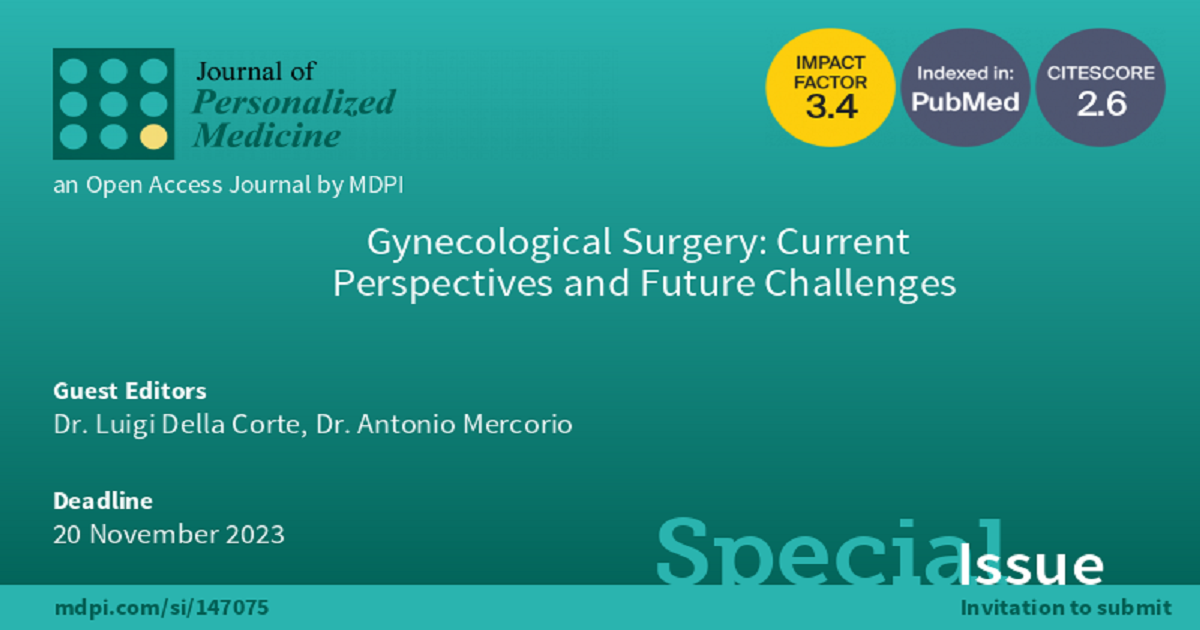Gynecological Surgery: Current Perspectives and Future Challenges
A special issue of Journal of Personalized Medicine (ISSN 2075-4426). This special issue belongs to the section "Clinical Medicine, Cell, and Organism Physiology".
Deadline for manuscript submissions: closed (20 August 2024) | Viewed by 14005

Special Issue Editors
Interests: oncological gynecology; ovarian cancer; vulvar cancer; endometriosis; PCOS
Special Issues, Collections and Topics in MDPI journals
Interests: minimally invasive surgery; endometriosis; infertility; reproductive disorders; uterine fibroids; endoscopy; polycystic ovarian syndrome
Special Issue Information
Dear Colleagues,
The world of benign and malignant gynecologic surgery is constantly expanding thanks to the improvement of minimally invasive surgical techniques and the ever-growing experience of gynecologists of the third millennium. The purpose of this Special Issue is to present studies on new surgical frontiers for the treatment of benign and, above all, malignant diseases, from endometrial cancers passing through that of the ovary, to those of the cervix and vulva. Alongside laparotomic and laparoscopic surgeries, the use of robot-assisted laparoscopic (RAL) surgery and vaginal natural orifice transluminal endoscopic surgery (vNOTES) has been increasing for years, allowing excellent surgical results as well as reduced operating times, shorter hospital stays, better aesthetic results and the possibility of carrying out the surgery under regional anesthesia.
As with medical therapy, surgery can now also be performed on the basis of not only the type of disease, but also the type of patient. Especially for malignant conditions, there is a need to highlight current perspectives with an eye to the future, allowing surgeons to work in harmony with clinicians—in particular, oncologists and radiotherapists. For these reasons, original articles, as well as systematic and narrative reviews of the literature, are welcome to be submitted to this Special Issue.
Dr. Luigi Della Corte
Dr. Antonio Mercorio
Guest Editors
Manuscript Submission Information
Manuscripts should be submitted online at www.mdpi.com by registering and logging in to this website. Once you are registered, click here to go to the submission form. Manuscripts can be submitted until the deadline. All submissions that pass pre-check are peer-reviewed. Accepted papers will be published continuously in the journal (as soon as accepted) and will be listed together on the special issue website. Research articles, review articles as well as short communications are invited. For planned papers, a title and short abstract (about 100 words) can be sent to the Editorial Office for announcement on this website.
Submitted manuscripts should not have been published previously, nor be under consideration for publication elsewhere (except conference proceedings papers). All manuscripts are thoroughly refereed through a single-blind peer-review process. A guide for authors and other relevant information for submission of manuscripts is available on the Instructions for Authors page. Journal of Personalized Medicine is an international peer-reviewed open access monthly journal published by MDPI.
Please visit the Instructions for Authors page before submitting a manuscript. The Article Processing Charge (APC) for publication in this open access journal is 2600 CHF (Swiss Francs). Submitted papers should be well formatted and use good English. Authors may use MDPI's English editing service prior to publication or during author revisions.
Keywords
- laparoscopy
- robot-assisted laparoscopic surgery
- vNOTES
- gynecological benign disease
- endometrial cancer
- ovarian cancer
- cervical cancer
- vulvar cancer
Benefits of Publishing in a Special Issue
- Ease of navigation: Grouping papers by topic helps scholars navigate broad scope journals more efficiently.
- Greater discoverability: Special Issues support the reach and impact of scientific research. Articles in Special Issues are more discoverable and cited more frequently.
- Expansion of research network: Special Issues facilitate connections among authors, fostering scientific collaborations.
- External promotion: Articles in Special Issues are often promoted through the journal's social media, increasing their visibility.
- e-Book format: Special Issues with more than 10 articles can be published as dedicated e-books, ensuring wide and rapid dissemination.
Further information on MDPI's Special Issue polices can be found here.







